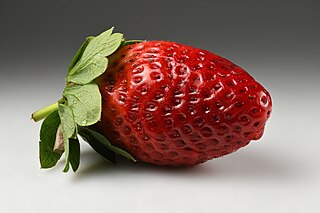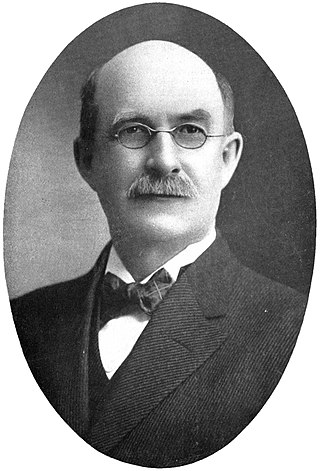
Sex is the trait that determines whether a sexually reproducing organism produces male or female gametes. During sexual reproduction, a male and a female gamete fuse to form a zygote, which develops into an offspring that inherits traits from each parent. By convention, organisms that produce smaller, more mobile gametes are called male, while organisms that produce larger, non-mobile gametes are called female. An organism that produces both types of gamete is hermaphrodite.

Basidiomycota is one of two large divisions that, together with the Ascomycota, constitute the subkingdom Dikarya within the kingdom Fungi. Members are known as basidiomycetes. More specifically, Basidiomycota includes these groups: agarics, puffballs, stinkhorns, bracket fungi, other polypores, jelly fungi, boletes, chanterelles, earth stars, smuts, bunts, rusts, mirror yeasts, and Cryptococcus, the human pathogenic yeast.

The garden strawberry is a widely grown hybrid species of the genus Fragaria, collectively known as the strawberries, which are cultivated worldwide for their fruit. The fruit is widely appreciated for its characteristic aroma, bright red color, juicy texture, and sweetness. It is consumed in large quantities, either fresh or in such prepared foods as jam, juice, pies, ice cream, milkshakes, and chocolates. Artificial strawberry flavorings and aromas are also widely used in products such as candy, soap, lip gloss, perfume, and many others.
Septobasidium bogoriense is a plant pathogen, one of a number of fungi in the genus Septobasidium responsible for the disease of tea plants known commonly as "velvet blight".
Septobasidium pseudopedicellatum is a plant pathogen infecting mangoes.
Septobasidium theae is a plant pathogen, one of a number of fungi in the genus Septobasidium responsible for the disease of tea plants known commonly as "velvet blight".
This glossary of botanical terms is a list of definitions of terms and concepts relevant to botany and plants in general. Terms of plant morphology are included here as well as at the more specific Glossary of plant morphology and Glossary of leaf morphology. For other related terms, see Glossary of phytopathology, Glossary of lichen terms, and List of Latin and Greek words commonly used in systematic names.

Septobasidium is a fungal genus within the family Septobasidiaceae. Approximately 175 described species are associated with this genus. 227 records are listed by Species Fungorum.

The Kriegeriales are an order of fungi in the subdivision Pucciniomycotina. Most species are known only from their yeast states and can be found in a variety of habitats, ranging from arctic waters to tropical ferns. Hyphal states produce auricularioid basidia.
Velvet blight is a disease that affects the stems, branches, leaves, fruits or trunks of plants and trees. This disease is primarily caused by three fungal species from the genus Septobasidium: S. bogoriense, S. pilosum and S. theae.

Edward Angus Burt was an American mycologist and an authority on the resupinate fungus family Thelephoraceae. He received his M.A. in 1894 and PhD. in 1895, both from Harvard University under William G. Farlow and Roland Thaxter. He became a Professor of Natural History at Middlebury College in 1895, then both a Professor of Botany at the Henry Shaw School of Botany at Washington University in St. Louis, and a mycologist for the Missouri Botanical Garden in 1913. He also worked on a systematic description of basidiomycetes such as Merulius and fungi from Vermont, Siberia, and Java.
Karel Bernard Boedijn was a Dutch botanist and mycologist. Born in Amsterdam, he graduated with a PhD from the University of Amsterdam in 1925; his thesis was titled "Der Zusammenhang zwischen den Chromosomen und Mutationen bei Oenothera lamarckiana".
Septobasidium polygoni is a plant pathogenic fungus in the genus Septobasidium. It was first isolated from Koenigia campanulata.
Septobasidium euryae-groffii is a plant pathogenic fungus in the genus Septobasidium. It was first isolated from Eurya groffii.
Septobasidium gaoligongense is a plant pathogenic fungus in the genus Septobasidium. It was first isolated from Eurya groffii.
Plants of the World Online (POWO) is an online database published by the Royal Botanic Gardens, Kew. It was launched in March 2017 with the ultimate aim being "to enable users to access information on all the world's known seed-bearing plants by 2020". The initial focus was on tropical African Floras, particularly Flora Zambesiaca, Flora of West Tropical Africa and Flora of Tropical East Africa.
Hemiberlesia lataniae, the latania or palm scale, is a species of armored scale insect in the family Diaspididae. It was first described by the French entomologist Victor Antoine Signoret in 1869 using Latania lontaroides, a species of palm tree endemic to Réunion as its host; since then, it has been found on avocado trees growing in South Africa, Australia, Israel, the United States, and on a range of other plants in many parts of the world.
Helicia nilagirica is a tree of the Proteaceae family. It grows from Thailand across Mainland Southeast Asia to Yunnan, Zhōngguó/China and over to Nepal. It is a source of wood, a pioneer reafforestation taxa, and an ethnomedicinal plant.
The Septobasidiales are an order of rust fungi in the class Pucciniomycetes. It contains the single family Septobasidiaceae, which itself comprises six genera: AphelariopsisJülich, AuriculoscyphaD.A. Reid & Manim., CoccidiodictyonOberw., JohncouchiaS. Hughes & Cavalc., SeptobasidiumPat. and lastly, UredinellaCouch.





